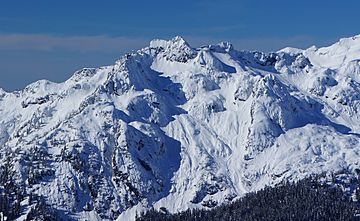Electric Butte facts for kids
Quick facts for kids Electric Butte |
|
|---|---|

Electric Butte seen from Oakes Peak
|
|
| Highest point | |
| Elevation | 6,400+ ft (1,950+ m) |
| Prominence | 720 ft (220 m) |
| Parent peak | Bacon Peak 7061 ft (2152 m) |
| Geography | |
| Parent range | North Cascades Cascade Range |
| Topo map | USGS Damnation Peak |
Electric Butte is a mountain in Washington state. It is about 6,400 feet (1,951 meters) tall. It's located in Whatcom County, near the edge of the North Cascades mountains. Even though it's called "Electric Butte," this name isn't official.
You can find Electric Butte north of Marblemount and Logger Butte. It is also inside the beautiful North Cascades National Park. The closest taller mountain is Canadian Bacon, which is about 1.44 miles (2.32 km) north. Another nearby peak is Bacon Peak, about 2.01 miles (3.23 km) to the northwest. Water from Electric Butte flows into streams that eventually join the Skagit River.
Contents
What is the Climate Like at Electric Butte?
Electric Butte is in a "marine west coast" climate zone. This means it's near the ocean and gets a lot of moisture. Most of the weather systems start over the Pacific Ocean. They then travel northeast towards the Cascade Mountains.
How Does Weather Affect the Mountains?
When these weather systems reach the North Cascades, the tall mountains force the air upwards. This process is called Orographic lift. As the air rises, it cools down and drops its moisture. This moisture falls as rain or snowfall onto the Cascades. Because of this, the western side of the North Cascades gets a lot of rain and snow. This is especially true during the winter months.
Temperatures and Snow in the Cascades
Thanks to the mild climate and being close to the Pacific Ocean, areas west of the Cascade mountain tops rarely get extremely cold or hot. Temperatures usually stay between 0°F (-18°C) and 80°F (27°C). In winter, it's often cloudy. However, in summer, high-pressure systems over the Pacific Ocean bring clear skies. The snow in this area tends to be wet and heavy because of the ocean's influence. This can sometimes lead to a higher risk of avalanches.
How Did Electric Butte Form?
The North Cascades mountains have very rugged land. You can see sharp peaks, long ridges, and deep valleys carved by glaciers. These amazing shapes and big changes in height happened over millions of years. They also led to the different climates we see across the Cascade Range.

The History of the Cascade Mountains
The Cascade Mountains started forming millions of years ago, during the late Eocene Epoch. At that time, the North American Plate was slowly moving over the Pacific Plate. This movement caused many volcanic eruptions. Also, small pieces of the Earth's crust, called terranes, came together to form the North Cascades about 50 million years ago.
How Glaciers Shaped the Land
During the Pleistocene period, which was over two million years ago, huge sheets of ice called glaciers moved across the land many times. As they moved, they scraped away rocks and left behind debris. The "U"-shaped valleys you see in the rivers today were created by these glaciers. The combination of the land being pushed up (called uplift) and cracks forming in the Earth (called faulting), along with the glaciers, created the tall peaks and deep valleys of the North Cascades.



